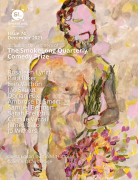“Life Size” is presented as one long sentence held together by commas. Because of its syntactical structure, the piece seems to build momentum as it unravels in what feels like an exhale. Was that effect intentional on your part?
The syntax in “Life Size” is entirely about catching your breath. I wanted this piece to feel like a series of steady inhalations, hyper-ventilations, and one final satisfying exhalation. At seventeen I was open-hearted, tumbling end over end (not so different from now, really). Desperate to transform the world, I signed up for City Year, an AmeriCorps program, believing in its altruistic nets cast far and wide. I became a “we” in an activist machine. The days were meticulously scheduled in a repetitive rise and fall, almost militaristic. My boundaries felt as permeable as commas. The syntax is the emotional rhythm to that time period, an urgent velocity that only stops in the open air again.
Depictions of size and space seem central to the piece. People are either giant or pocket-sized, while the spaces they inhabit are pressed between windows and buildings, yet infinite as the sky. How do those depictions speak to themes of life and death within the piece?
Proportion gets warped when you try to help a community but keep yourself apart from it, even in well intentioned ways. The entire corps lined up every morning in Kennedy Plaza to step dance while the buses rolled in around us, and Providence woke up (which was my favorite part, maybe because we were dancing). We stomped. We made noise. We were all trying really hard. But we were separate from the people who strolled a few feet away from us, insular in our excited philanthropy. Even if we earned below the poverty line ourselves, we remained giants in our uniforms. We quite literally draw the eye: as a corps, we became bigger, more noticeable than the people that we helped. I stretched and shrunk people on the page based on who we were in some exaggerated, altruistic script. It’s about authority. The life-sized people at the end stroll downtown in their bodies as they are, not stretching or shrinking who they are in relation to others, open to infinite space.
“Life Size” focuses largely on one scene in which a shooting that takes place on a film set is mistaken for reality. Despite discovering that the shooting is merely acting, the speaker seems disturbed by the event, and the end of the piece shifts briefly to the speaker’s inner turmoil. Can you talk about the significance of that shift?
Even if the stage death in “Life Size” is artistic, the effect is the same: witnesses helplessly banging on a glass coffin from the inside. The style ruptures by shifting person from we to I: “we-I-we screamed.” The shooting shakes the speaker right out of collective and back into their own body. A human is about to die. They’re dead. Oh, I’m a human, too. I’m going to die someday. Death is what unites us. (Sorry, mood killer.) In a piece about being helpful, this is a moment of total helplessness. An awakening to limitation. The speaker isn’t a cog in a nebulous machine anymore, but a person with limitations that they’re suppressing. I was deeply depressed back then. I still grapple with major depression, but as a teenager, I pushed that reality underneath my pressed polo shirt and pressed on. The shift in perspective forces a reinvestigation of helping and how to ask for help in return.
As you’ve mentioned, the speaker is folding uniforms for City Year at the opening of “Life Size.” At the end, their “corduroys and stained Converse” seem totally in contrast to those uniforms and the workplace in general. How is that contrast central to the narrative?
We folded so many uniforms. The early days remind me of that video game, Katamari Damaci, like a giant altruistic rolling ball, all of us trailing out into Providence in uniform to swoop up more people to wear uniforms to fold more uniforms to recruit more people to wear uniforms. I felt absorbed into this nebulous-institutional-creature of well meaning people. Part of the corps gig required us to be model citizens. Perfect, even. It was not enough to help, but we must be witnessed as a well-behaved and coifed beast. There was a laughable rumor that there were spies watching us all over Providence, so we should never step out of line. Did you jaywalk? You’ll be tattled on by someone hovering in a window on Westminster! If I did experience so many beautiful interactions within the community during my time there, perhaps I was simply not corps material. Mostly I was a scruffy punk who hung around on Thayer Street in Providence thumbing used books and eating falafels. I could say I ditched the corduroys and stained Converse eventually, but that’s literally what I’m wearing right now. If I quit and started slinging sandwiches and books right afterward, I was much more integrated with community, because I was just another human within it. My activism became deeply personal, weirder, closer to the filmmakers on the rooftop.
If you had to pick just one, which single piece of creative nonfiction has most inspired your own work?
This is such an evil question, Mary. But if I have to choose: Eve Kosofsky Sedgwick’s A Dialogue on Love, her multi-faceted writings on her relationship with her therapist. Back when I first read that book, I just had no idea that you could write something like that, so tangled and engaged and loving and vulnerable. I’m a hybrid fiend, and she played with form in daring ways, mixing creative nonfiction and poetry.



 The SmokeLong Grand Micro Contest (The Mikey) is now an annual competition celebrating and compensating the best micro fiction and nonfiction online.
The SmokeLong Grand Micro Contest (The Mikey) is now an annual competition celebrating and compensating the best micro fiction and nonfiction online.